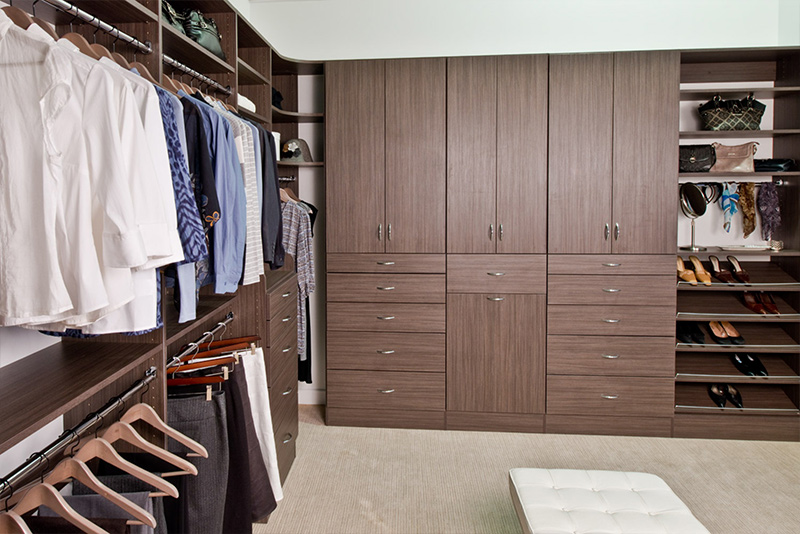
The closet: we all take it for granted, that little space tucked between the joists of two rooms, designed to house our apparel.
However, in the Middle Ages the closet, like the notion of a private suite of rooms dedicated to sleep, dressing, occasional ‘sitting’ and, in more elaborate circumstances – ‘entertaining’ (a word of varying meaning) was very much considered a sign of prestige…or worse, vanity run amuck. In an era when most people slept on comforters on the floor nearest the kitchen grate (to keep warm) and had but two – maybe three – distinct pieces of clothing to their name (and rarely more than one pair of shoes) who – outside the aristocracy – really needed a closet?
As the bedroom (again, if one could afford it) was decidedly a part of the ‘public’ space in a family home it fell to the closet to provide a more intimate setting where one could retire from the cares of the day. And thus, the idea we know as ‘the closet’ today was born. Affluent homeowners used closets as a sort of secluded treasure trove for their most prized possessions. But the closet also did double duty as a place of quiet reflection and worship; hence, the lingering notion today that closets somehow harbor our most intimate thoughts. Think of two people hushed in ‘closeted conversation’ or the sixties idea of “coming out of the closet” to reflect one’s newfound sexual liberation. In Europe, the closet curiously fell out of favor in the 20th century, partly as homes grew larger and rooms devoted to personal privacy took their place. Mercifully, the Puritans were not about to let a good thing go to waste. And so, the closet crossed the Atlantic to ‘the New World’.
Actually, we should thank the Puritans for today’s common closet; a place to store clothing and other items made readily accessible, yet most immediately out of sight and mind at a glance. This overriding principle in closet design persisted throughout the early to mid-20th century; closets designed with just enough space to accommodate a few choice pieces of clothing and, perhaps, a modest shoe rack at the bottom. But as many of us are now able to afford more elaborate wardrobes, sometimes teetering on obsessive hoarding, the closet has experienced its boldest renaissance yet. It has become a room unto itself, meticulously designed to accommodate, complete with vanities, seating arrangements, writing desks, etc. et al.
A closet is no longer a luxury, but a necessity; an integral part of that place we call home. In only 35 years, we have gone from the single-louver-door closet to, at its most ostentatious, a very chichi staging area favoring the stylized Parisian atelier or one of the swankiest private shops lining Saville Row. This migration from simple to chic has been largely hastened by the need to accommodate lady’s fashion: gowns, dresses, hats, skirts, business suits, furs, silky unmentionables and other bedroom attire, purses and handbags, perfume, jewelry, and yes – shoes…lots of them! But closets also house items unrelated to dressing. Towels, bedding, toiletry and cleaning supplies, perhaps a vacuum cleaner and other household necessities, etc.
To maximize a closet’s truest potential, one need only look to a design professional for counsel and advice. Not all closets are equal and not all closets need to serve multiple purposes in tandem. Conversely, not every closet needs to be an elaborate extension of our living space. But virtually all should conform to one’s personal mantra. Above everything else, a closet should be functional to an individual’s needs. You wouldn’t put a bottle of Mop n’ Glow and extra cleaning rags next to a ball gown would you? You wouldn’t want your exercise shoes stuck in a drawer next to a cherished family heirloom broach? So, closets fundamentally serve to ensure everything is in its proper place; clean, neat, organized and always at arm’s length.
An organized bedroom closet can be achieved on a limited budget. But of course, built-ins and walk-ins require more planning and money to make them a reality. There are lots of ways to build a closet. But one of the simplest ways to create the perfect ‘walk-in’ is to commandeer an existing bedroom and convert it. The hallmarks of a well-conceived closet are immediately apparent when you throw open the doors. Personally, if one has the room, then I prefer real doors to the louver kind. When you look inside a closet everything you need should be accessible at a glance; no rummaging about or head-scratching as to what has become of a certain piece you were looking to wear right now.
Group like items together in a way that makes sense for you: a rack for skirts, next to another for slacks and shelves for sweaters and the common T-shirt. Under more elaborate circumstances, you may even want to divide your wardrobe according to season or split the items between those worn ‘every day’ – business vs. casual – and have an entirely separate area for the more formal attire trotted out for very special occasions (tuxedos, bow ties, gowns, etc. et al) with racks and drawers of complimentary shoes, jewelry etc. You should be able to simply grab from columns ‘A’, ‘B’ and ‘C’ to coordinate your wardrobe for the day or evening. The well organized closet will help you get ready in record time. It’s the most efficient way to manage more complex wardrobes.Put lighter items like blouses and shirts on the top rods of your double hangers, and, jackets and short skirts on the lower rod. Hang pants at a 3/4 height to keep their seams in line. Most people need a lot more double hangers at this length. If space permits, its prudent to have a coat and shoe closet near your front door; the easiest way to cap off your outfit with some easily reachable outer wear (scarves, gloves, etc.) and maybe an umbrella, in case of inclement weather.
Choosing a color scheme for your closet is highly subjective. But neutrals tend to work the best, showing off the clothes to their best advantage. Think white, beige, light grey. It’s hard, for example, to see a crimson sweater hanging in a cubby painted ox-blood red. But whatever your decision, your color scheme should compliment your personal tastes. If there is room, an island in your walk-in is a great idea; a place to lay out your options.
An island can also provide more storage space along with drawers for jewelry, handkerchiefs, and other easily misplaced smaller clothing items, like cufflinks and watches. You can also use some of this storage for underwear, nylons and socks. The ideal walk-in should also have a clothes steamer and ironing board. You can have a built-in ‘fold-out’ ironing board that recesses into the wall or, if there is room, a stand alone tradtional ironing board that gets folded up and either hung or put away inside another narrow wall storage unit.
Last but not least, are the finishing touches; an opportunity for you to personalize the space with either all the bling or minimalism your heart desires. All closets should be well-lit. Pot lights are the most efficient. But there is also room for crystal chandeliers, drum lights, wall sconces, etc. Add to the lighting, comfortable sitting chairs, cloth or leather-covered benches and ottomans. If you can conceive it, you can definitely achieve it with a little creative personal panache applied. Bottom line: if your closet is well-organized and stylish it is a pleasure to throw open those doors and browse. It also helps to identify holes in your wardrobe; items either currently missing from your boudoir or perhaps in need of retirement and/or freshening up. But in the end, a well-organized closet will alleviate a lot of stress. It will also expedite the amount of time it takes for you to get ready.
If you are thinking about creating such an oasis or merely looking for creative ways to declutter an existing closet space, call me today for inspiration. I will dedicate myself to helping you get the most out of your closet space.
Maria Kozmor
Interior designer

